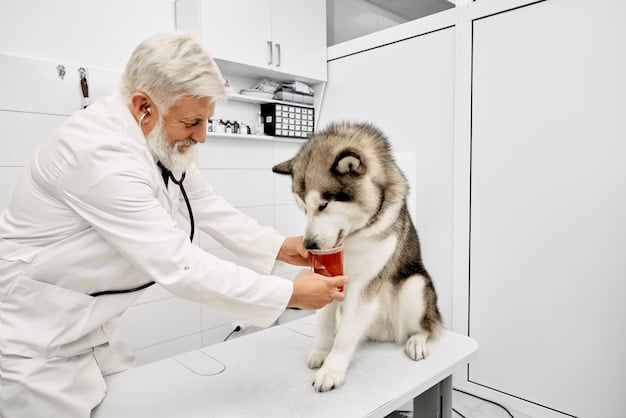Arthritis in Senior Pets: 5 Strategies for Pain Relief & Mobility

Anúncios
Arthritis in senior pets is a common issue that can significantly impact their mobility and quality of life; however, with strategies such as weight management, appropriate exercise, joint supplements, pain medication, and environmental modifications, you can manage your senior pet’s arthritis and enhance their comfort.
Watching your beloved senior pet struggle with arthritis in senior pets can be heartbreaking. Seeing them limp, hesitate to jump, or show signs of stiffness is a clear indication that their joints are causing them pain. Thankfully, there are several proven strategies you can employ to improve their mobility, reduce their discomfort, and help them enjoy their golden years to the fullest.
Anúncios
Understanding Arthritis in Senior Pets
Arthritis, also known as osteoarthritis or degenerative joint disease, is a progressive condition that affects the joints, causing pain, inflammation, and reduced mobility. As pets age, the cartilage that cushions their joints begins to break down, leading to bone-on-bone friction. This friction results in the development of bone spurs and inflammation, which contribute to chronic pain and discomfort.
Recognizing the signs of arthritis early can make a significant difference in managing the condition. Some common symptoms include:
Anúncios
- Stiffness, especially after resting
- Limping or favoring one leg
- Difficulty getting up or lying down
- Hesitation to jump or climb stairs
- Reduced activity levels
- Irritability when touched near affected joints
- Changes in appetite or sleep patterns
If you notice any of these signs in your senior pet, it is important to consult with your veterinarian for a proper diagnosis. Early intervention can help slow the progression of the disease and improve your pet’s quality of life. Understanding the underlying causes and symptoms of arthritis is the first step in providing effective care and support for your senior companion.
Arthritis affects a significant portion of the senior pet population. By recognizing symptoms early and working closely with your veterinarian, you can take proactive steps to manage the condition and ensure your pet’s comfort and well-being.

Strategy 1: Weight Management for Joint Health
Maintaining a healthy weight is crucial for managing arthritis in senior pets. Excess weight puts additional stress on the joints, exacerbating pain and accelerating the progression of the disease. By helping your pet achieve and maintain an ideal weight, you can significantly reduce the pressure on their joints and improve their mobility. Here are some strategies for effective weight management:
Assess Your Pet’s Current Weight
Work with your veterinarian to determine your pet’s ideal body weight. They can assess your pet’s body condition score (BCS) and provide guidance on the appropriate weight loss or maintenance plan.
Dietary Adjustments
Choose a high-quality pet food formulated for weight management. These diets are typically lower in calories and fat, and higher in fiber, which can help your pet feel full and satisfied while consuming fewer calories. Measure food portions carefully and avoid free-feeding.
- Reduce the amount of treats and snacks you give your senior pet.
- Opt for healthy alternatives like carrots or green beans.
- Avoid giving table scraps, as they can be high in calories and unhealthy fats.
Regular Exercise
Gentle exercise can help your pet burn calories and maintain muscle mass, which is essential for supporting the joints. Short, frequent walks are often better than long, strenuous activities. Avoid high-impact exercises like running or jumping, which can put excessive stress on the joints.
Weight management is a cornerstone of arthritis management in senior pets. By working closely with your veterinarian to develop a tailored plan, you can help your pet achieve and maintain a healthy weight, reduce pain, and improve mobility.
Strategy 2: Appropriate Exercise Regimen
While it may seem counterintuitive, exercise is a key component in managing arthritis in senior pets. Regular, low-impact exercise helps to maintain joint mobility, strengthen muscles, and improve circulation. However, it is important to choose the right types of exercise and avoid activities that could cause further injury or pain. Here’s how to develop an appropriate exercise regimen for your arthritic senior pet:
Low-Impact Activities
Focus on activities that are gentle on the joints, such as walking, swimming, and gentle stretching. Short, frequent walks on soft surfaces are ideal. Swimming is an excellent option because it provides a full-body workout without putting stress on the joints.
Avoid high-impact exercises like running, jumping, and playing fetch, which can exacerbate pain and inflammation.
Consistency is Key
Establish a consistent exercise routine and stick to it as much as possible. Aim for short, frequent sessions rather than long, infrequent ones. This will help keep your pet’s joints mobile and muscles strong.
Listen to Your Pet
Pay close attention to your pet’s body language and adjust the exercise routine accordingly. If your pet shows signs of pain or fatigue, stop immediately. It is better to err on the side of caution and avoid pushing your pet too hard.
An appropriate exercise regimen, tailored to your pet’s individual needs and limitations, can help to improve their mobility, reduce pain, and enhance their quality of life. Always consult with your veterinarian before starting a new exercise program to ensure it is safe and effective for your senior companion.

Strategy 3: Joint Supplements
Joint supplements can play a vital role in supporting joint health and reducing pain in senior pets with arthritis. These supplements typically contain ingredients that help to protect and repair cartilage, reduce inflammation, and improve joint lubrication. While supplements are not a cure for arthritis, they can provide significant relief and improve your pet’s mobility. Here are some common joint supplements and their benefits:
Glucosamine and Chondroitin
Glucosamine and chondroitin are two of the most well-known and widely used joint supplements for pets. Glucosamine helps to stimulate cartilage production, while chondroitin inhibits the enzymes that break down cartilage.
When used together, they have a synergistic effect, providing even greater benefits for joint health. These supplements are available in a variety of forms, including chewable tablets, capsules, and powders.
Omega-3 Fatty Acids
Omega-3 fatty acids, particularly EPA (eicosapentaenoic acid) and DHA (docosahexaenoic acid), have potent anti-inflammatory properties. Supplementing your pet’s diet with omega-3 fatty acids can help to reduce joint inflammation and alleviate pain.
Common sources of omega-3 fatty acids include fish oil, flaxseed oil, and algae oil. Fish oil is generally considered the most effective source, as it contains higher concentrations of EPA and DHA.
Other Beneficial Supplements
- Turmeric and Curcumin: Known for their anti-inflammatory properties, turmeric and curcumin can help reduce joint pain and stiffness.
- MSM (Methylsulfonylmethane): MSM is a natural sulfur compound that supports joint health by reducing inflammation and promoting cartilage repair.
- Avocado-Soybean Unsaponifiables (ASU): ASU is a plant extract that has been shown to reduce inflammation and protect cartilage.
Joint supplements can be a valuable addition to your pet’s arthritis management plan. However, it is important to choose high-quality supplements and consult with your veterinarian to determine the appropriate dosage and combination of ingredients. With consistent use, joint supplements can help to improve your pet’s mobility, reduce pain, and enhance their overall quality of life.
Strategy 4: Pain Medication
Pain medication is often necessary to manage arthritis pain in senior pets, especially when other strategies are not enough. There are several types of pain medications available, each with its own benefits and potential side effects. It is important to work closely with your veterinarian to determine the most appropriate medication for your pet’s individual needs. Here are some common pain medications used to treat arthritis in pets:
Nonsteroidal Anti-Inflammatory Drugs (NSAIDs)
NSAIDs are the most commonly prescribed pain medications for arthritis in pets. They work by reducing inflammation and alleviating pain. NSAIDs are generally effective, but they can have potential side effects, such as gastrointestinal upset, liver damage, and kidney damage. It is important to monitor your pet closely while they are taking NSAIDs and report any adverse effects to your veterinarian.
Other Pain Medications
In addition to NSAIDs, there are other pain medications that can be used to manage arthritis pain in pets.
- Amantadine: An antiviral drug that has also been shown to provide pain relief in pets. It is often used in combination with NSAIDs or other pain medications.
- Gabapentin: An anticonvulsant drug that can also be used to treat nerve pain in pets. It is often used for pets with chronic pain or those who cannot tolerate NSAIDs.
- Tramadol: An opioid pain medication that can provide relief from moderate to severe pain. However, it is less effective than NSAIDs for many pets and can have potential side effects, such as sedation and constipation.
Pain medication can be an essential part of managing arthritis pain in senior pets. By working closely with your veterinarian to choose the right medication and monitor for potential side effects, you can help your pet live a more comfortable and active life.
Strategy 5: Environmental Modifications
Making simple changes to your home environment can greatly improve the comfort and mobility of your senior pet with arthritis. These modifications can help to reduce stress on their joints and make it easier for them to navigate their surroundings. Here are some effective environmental modifications to consider:
Soft Bedding
Provide your pet with a soft, comfortable bed that cushions their joints and provides support. Orthopedic beds made of memory foam are an excellent choice, as they conform to your pet’s body and relieve pressure points.
Ramps and Stairs
If your pet has difficulty jumping onto furniture or climbing stairs, consider providing ramps or pet stairs to help them reach these areas more easily. This can reduce the stress on their joints and prevent injuries.
Non-Slip Flooring
Hardwood or tile floors can be slippery and difficult for arthritic pets to navigate. Place rugs or carpets in areas where your pet spends a lot of time to provide better traction and prevent falls.
Environmental modifications can make a significant difference in the comfort and mobility of your senior pet with arthritis. By making these simple changes to your home environment, you can help your pet live a more comfortable and active life, despite their arthritis.
| Key Point | Brief Description |
|---|---|
| ⚖️ Weight Management | Reduces joint stress and pain, improving mobility. |
| 🚶 Exercise | Maintains mobility and strengthens muscles for support. |
| 💊 Supplements | Supports cartilage and reduces inflammation. |
| 🏡 Home modifications | Ramps, soft bedding and carpets can help senior dogs with their mobility. |
Frequently Asked Questions (FAQs)
▼
Early signs include stiffness, limping, difficulty getting up or down, reluctance to jump or climb stairs, and decreased activity levels. Watch for changes in your pet’s behavior.
▼
Weight management reduces stress on the joints, decreases pain, and improves mobility. Consult your vet for the ideal weight and diet plan for your pet.
▼
Low-impact activities like walking on soft surfaces and swimming are ideal. Avoid high-impact activities like running and jumping. Consistency is key; do a little regularly.
▼
Yes, when used consistently, joint supplements like glucosamine and omega-3 fatty acids can protect cartilage and reduce inflammation, improving mobility and reducing pain.
▼
Provide soft bedding, ramps or stairs, and non-slip flooring. This can reduce stress on joints and help your pet navigate their surroundings more easily and safely.
Conclusion
Managing arthritis in senior pets involves a multifaceted approach that includes weight management, appropriate exercise, joint supplements, pain medication when necessary, and environmental modifications. By implementing these strategies and working closely with your veterinarian, you can significantly improve your pet’s comfort, mobility, and overall quality of life, ensuring they enjoy their senior years to the fullest.






